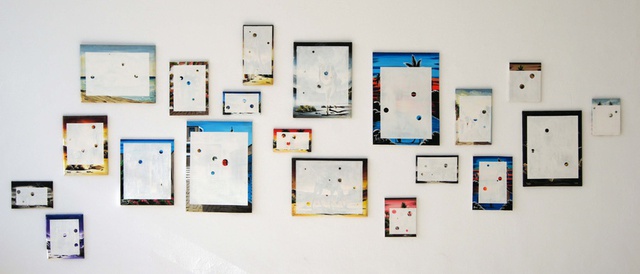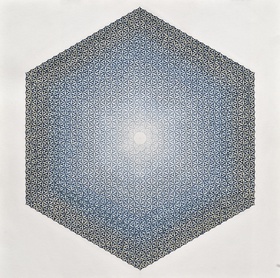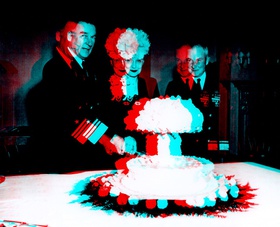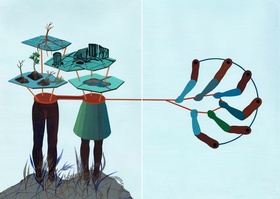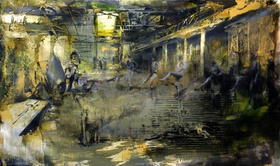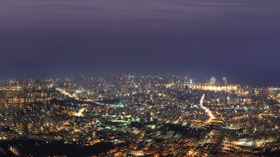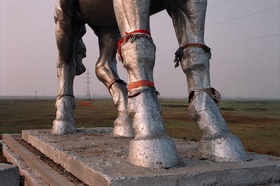Interviews
Meanwhile…History
Shumon Basar, Ala Younis and Omar Berrada in conversation with Sheyma Buali
The 2014 Global Art Forum (GAF) – the eighth edition of this series staged annually at Art Dubai – is an imagined timeline of turning points in history. It seeks out significant decades, years, days, minutes or seconds that shifted an understanding of the world that are either familiar or are broadcast from history's blind spots. On the occasion of the 8th Global Art Forum, Ibraaz editorial correspondent Sheyma Buali talked to this year's GAF Co-Directors, curator-translator Omar Berrada of Dar al-Ma'mun and artist Ala Younis, as well as Commissioner Shumon Basar, about what to expect from this year's intellectual mash up of speakers and themes. This year's forum will be streamed online via Ibraaz from 19–21 March – and we will be publishing exclusive interviews and panel discussions online thereafter.
Part I: Shumon Basar, Commissioner of Global Art Forum 8
Sheyma Buali: You've been working on the Global Art Forum (GAF) for a few years now. How have you seen it evolve and develop?
Shumon Basar: In 2012 we effectively 'rebooted' the franchise, to borrow a favourite Hollywood term, which is to say: we decided that the Forum ought to have a greater autonomy than it had up till then. So, we emancipated the content. It no longer deals exclusively with art and indeed is almost libidinally liberated from disquisitions on the art market (which may seem strange, given our fraternal link to Art Dubai, an art fair).
Secondly, we reinvented the form of the forum: it became more like a media production than a conference. We commission artists to make video blips between the sessions; Fatima al-Qadiri composed a soundtrack to inaugurate each forum day last year; there is a publishing initiative called Globe Books; and there have been more musical performances – such an Andre Vida in Doha or Hassan Khan in Dubai in 2013. The forum elects a theme each year – such as media, definitions and now elided history – and builds a sort of temporary university/TV station around it. The stage feels like a chat show rather than an academic conference or an awkward Greek wedding. That's very different to what still happens at most art fair programmes (not in any way to demean them. We have yet to attract Kanye West, for example).
SB: Why did you come to 'history' as your focal point for this year's GAF? As in, why history and why now?
Shumon Basar: 2013's Global Art Forum, co-directed with H.G. Masters, was titled It Means This, and constructed a partial and yet urgent glossary of words and terms that were helpful in navigating the early twenty-first century. This year, instead of definitions, we are gathering dates on an imaginary timeline. These are forgotten, lost or erased dates and attendant events that somehow transformed the world. Both Doha and Dubai have famously accelerated their developments at hurtling speed. This makes ten years ago seem like a century ago. Time and memory are compressed and distorted in these kinds of environments – while at the same time, there is a concerted effort to somehow compensate for absent material histories, the 'myth of the desert', if you will. The status of history in relation to brilliant new futures is arguably different here than it is in the western world, or even in, say, the east. In parallel, we look at the philosophy and fiction of history – from Ibn Khaldun to John Akomfrah. These are timeless themes. History has the peculiar quality of both ageing and remaining utterly present at the same time.
SB: Apart from the 'sessions', which will cover a wide area of space and time – you have other programmes: the Forum Fellows and the Forum Forum. Let's start with Forum Fellows: according to the online description, it has a 'long run' plan. Can you talk a bit more about this plan, what the imagined outcome is, and the choice of having Tirdad Zolghadr as the programme's 'lead tutor'?
Shumon Basar: The Forum Fellows runs on a three-year cycle. It started with Tirdad and a group of curators; then Kaelen Wilson-Goldie hosted a coterie of art writers; and last year Omar Berrada brought together translators. So, we are looping around to Tirdad again, and he remains one of the most insistent people thinking about the pros and cons of curating. He's also pan-Euro-American-Persian, and this worldliness is precious when it comes to the invited young emerging curators who hail from backgrounds where the discourse around curating may or may not be alive yet. I would say the Forum Fellows is first and foremost an act of generosity founded on invitation. The outcomes are less calculated. Much of Art Dubai and its associated archipelago elicit encounters that lead to future possibilities – all this surrounded by bubbling fountains, a proximate beach and the arachnid Burj al Arab.
SB: The Forum Forum on the other hand, sounds like it is two things: a 'media repository', which should be a physical space, and a set of commissions. What will be in the repository and how will the new commissions, which will be on show during the GAF sessions in one way or another, fit into that?
Shumon Basar: The Forum Forum has morphed over the last few years but essentially it contains material that the Forum has commissioned, such as publications and artist videos as well as sometimes extant work related to the overall theme; and it also now operates as an archive for previous Global Art Forums. We will include video recordings from the 2012 and 2013 editions, and will also be streaming this year's live events into the main public area of the fair. Since the forum just lasts three hours every day, the Forum Forum is a physical island that encapsulates the spirit of the live forum for people throughout the days of the fair. We also have a very tall tree.
PART II: Ala Younis, Co-Director of Global Art Forum 8
SB: How did you get involved with the Global Art Forum this year and what was your role exactly as Co-Director?
Ala Younis: My relationship with the GAF first started when I spoke there in 2013. A few of us came together to somehow define 'the Middle East'. There was a structure of long and short presentations; mine was to present one definition of the Middle East, but also to relate that to personal experiences and contemporary times.
This year, I received an email from Shumon Basar asking me to co-direct the 8th Edition of the Global Art Forum. The general concept that they had already thought of before inviting us was Meanwhile… History. There was an interest in doing something about Kuwait, and since I have been researching Kuwait extensively for other projects, it was interesting to present something on Kuwait during the 1970s. Between all of these elements, the most exciting thing for me to focus on was this decade of experimentation.
My role as Co-Director was focused on suggesting speakers and working on sessions. I came across a very long voice recording – about 12 and a half hours – of Al Muqaddimah by Ibn Khaldun, so we are including that. There are other sessions about the region, pearl fishing, and other concepts.
SB: Seeing that you often work with histories, particularly less-stated ones, both in your curatorial and artistic practices, how did you approach the theme on this scale?
Ala Younis: The way I thought of it was to bring together a few cultural endeavours, looking at theatre, architecture and art, and to trace this spirit of experimentation of the 1970s era that I am interested in. In general, there have been few famous stories like Andy Warhol's visit to Kuwait and his exhibition there in 1977, as well as the interesting architectural projects completed then, including the Kuwait Airport designed by Kenzo Tange or the Parliament House designed by Jørn Utzon in addition to projects by Hassan Fathy, and others. Kuwait was very inviting towards bringing in architectural concepts from around the world.
I was also interested in theatre; and I heard a few of Sulayman al-Bassam's interviews online talking about theatre education and practice in schools; how schools were not only to be a place where information was fed to young people, but also an extension of other things. I already knew that the first art exhibition ever in Kuwait took place in the Al-Mubarakiya School in 1942, as did the first theatre play back in the 1930s, the Free Atelier started in the school, too. The Free Atelier was interesting as it offered Kuwaiti artists a space to work and receive guests, and for the state to receive artist guests. Local artists were also given sabbatical leaves and funding. But the questions here are: how did this help or not help Kuwaiti artists? There are many of these sorts of stories that have to do with history, but they are more recent so we can trace their results in our own time.
SB: How did your project, Museum of Manufactured Response to Absence (MoMRtA), which also looked at a particular history, influence your plan for the GAF?
Ala Younis: My research had to look for pioneering moments; it had to find what was unique to this state and this time. For MoMRtA, I was looking at the years between 1936 and 1990, not too far from the years of my session at the Global Art Forum. I kept coming across stories like the first bank, the first tower, the first ice skating centre in the Arab world, and other different stories. I have had a focus in the past three years on Kuwait in one way or another so I kept coming across documentaries, notes, posts and so on. We are harvesting the results of looking into these stories.
SB: You mentioned that you are most excited about the experimentation era of the 1970s. The session you are moderating is entitled '1942–1982: Kuwait's Experiments and the Confidence Interval'. What can we expect in this session?
Ala Younis: Yes, I think that it was a more daring and inviting time, and very vivid. But I am trying to find out if this idea I have of that period is accurate. That's why I have titled my session 'Confidence Interval'. My idea is that within this 'interval', between 1942 and 1982, there is a strong sense of innovation and risk-taking. If we look at theatre, architecture, stock market systems (which crashed in 1982), we find that this confidence interval is true. Al-Bassam, for example, looks at history and the golden times of places or people and works with these kinds of legacies. One of his works, 'The Speaker's Progress' is about this group of researchers dissecting a play that was a great hit in the 1960s. This was a starting point for inviting him to participate, as he is working on readings of texts of his plays, which are about dissecting history and looking at how we live with what we inherited from other times.
Farah al-Nakib has done extensive research on the architectural marvels in Kuwait. She is very knowledgeable of these structures, which were designed by the 'starchitects' of their time, and has looked at how they reflected the spirit of excitement and experimentation that characterized Kuwait's early oil development. In her work, she also looks into how most of these buildings by these iconic architects have been entirely transformed into unrecognizable structures, with little public reaction.
Kristine Khouri, on the other hand, has been studying the history of the Sultan Gallery in Kuwait as part of an exploration of Pan-Arab sites and events of the 1970s. Adding to this research are her own findings from the interviews she conducted with collectors, artists, gallery owners, as well as the archives she had access to. One idea that we discussed was a presentation entirely made of response or quotations from these interviews that eventually give an interesting description of the art scene during that period.
To me, Kuwait is genuinely interesting. It takes time, but we continue to discover other places in the Gulf, and there are some patterns. There continues to be potential for interesting readings, and we are trying to see this logically and scientifically and in relation to parallel places and times. What is beyond a star's visit to or project in Kuwait? What did it mean that in the 1970s there was theatrical development within the scene, with new smaller groups forming and performing and writing? It will be great to have a chance to go into these depths by way of what the speakers have to say from their own individual practices.
PART III: Omar Berrada, Co-Director of Global Art Forum 8
SB: How did you get involved with the Global Art Forum this year and what was your role as Co-Director?
Omar Berrada: I was a speaker last year. It was my first time attending the forum in its entirety, and it was truly an experience of basking in a sun of friendship and intellectual excitement. When I was first invited to participate with a 20-minute 'Frant' (Friendly Rant), I remember trying to come up with a topic that would have a direct relation to contemporary visual arts in the MENA region, or something to do with globalization and the art market. But Shumon Basar made it clear that this was a forum for conversations and opening horizons, and that there was no reason to limit the field of investigation or try to conform to some preconceived idea of what a talk in an art fair is supposed to be like.
My role as Co-Director this year involves contributing to conceiving the programme of talks. Once the general theme, Meanwhile…History, was established, we would have conversations in order to make choices among a variety of possible topics and speakers, and figure out how to articulate them within an eclectic yet coherent programme. Conceptually, we worked on two levels: an exploratory one and a reflective one. On the one hand, we are focusing in on specific moments in time (days, years, decades) in order to build a GAF timeline of turning points in history, acknowledged or forgotten. On the other hand, we are looking at how history gets written as well as how our individual and collective memories of such events get constituted.
SB: How did your background as a writer and translator influence the way you approached this year's theme of Meanwhile…History?
Omar Berrada: It is not easy to answer your question, provided my background necessarily influences everything I do. The eclectic nature of the Global Art Forum allows us to approach the theme from different angles, in an attempt to make different worlds and disciplines meet. Among the speakers, we have artists, architects, art historians, writers, anthropologists and curators – you name it. Each of them will delve into a minute area of specialty, while at the same time discussing ideas that are universal, and of interest to a wide range of people. Some of the conversations will have to do with medieval times, while some will be about very recent histories, or even future histories…
SB: Future histories – in what sense?
Omar Berrada: I am thinking of the Documenta panel, which is called '1955–2055: A Documenta Century'. It's a history of an event that has shaped the transformations and the identity of contemporary art. But we thought that it would be interesting to ask people like Catherine David and Okwui Enwezor, who have been involved in shaping the history of Documenta, to imagine its future. There is this idea of looking into the past in order to be able to imagine the future.
SB: What can we expect in the discussion you will be mediating: 'Meanwhile … Meanwhile: Lapses in Time and Narrative'?
Omar Berrada: The discussion will involve Marina Warner and John Akomfrah and will explore the notion of ellipsis, or time gaps, as dealt with by writers and filmmakers. Marina Warner, an encyclopedic mind who is both an essayist and a fiction writer, is one of the world's foremost authorities on fairy tales. So one of the questions I would like to ask her is: what is it that happens in the 'happily ever after'? What is the future of a fairy tale's character? But we will also talk about the different temporalities in the life of a work of art, and time gaps between the production and the reception of a work, for instance.
John Akomfrah's work as a filmmaker is hard to characterize, but he is certainly interested in notions of transience and liminal spaces. He also explores ideas of futurity, specifically Afrofuturism in his 1995 film The Last Angel of History for instance, which dwells on the work of Sun Ra and others. How is going into outer space a way of actually leaving history?
SB: What are you most interested in when it comes to the Global Art Forum's programme this year?
Omar Berrada: I'm fascinated by the panels with topics I know next to nothing about, especially ones about the Gulf. I think it is crucial that GAF devotes a reasonable portion of its programme to Gulf-related topics, as most people who are not from there are ignorant of its history, or don't even believe it has one. They consider it to be a futuristic dream that emerged from a desert three or four decades ago; hence the importance of looking at the history of the pearling industry in the Gulf, or the so-called 'confidence interval' in Kuwait.
SB: Do you have a concern that some of the narratives will overlap?
Omar Berrada: Beside the ignorance of the history of the Gulf or the Arab region from the outside, there is also, of course, forgetfulness from the inside. After all, histories of decolonization are recent. Morocco, where I am from, has only been independent since 1956. At the time of anti-colonial struggle and nation building, it was strategically important to come up with a single narrative of history and identity, so that a whole nation would unite under its own banner and rise free from colonial discourses it had internalized. But this has solidified certain national myths that, several decades later, are hard to shake out of the popular imagination, even though repressed narratives, as we know, want to return – and the 'Arab Spring' may partly be an example of that. I believe it is important to liberate as many narratives of our past as possible. And it is everyone's task. Historians are doing it, of course, and so are artists working with archives and documents. It is about looking into the past in order to help us imagine potential futures.

